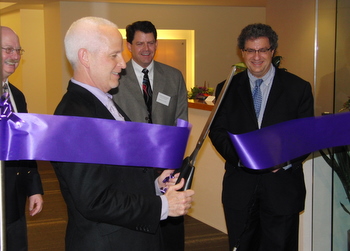NUPOC Hosts Ribbon Cutting, Open House
to Commemorate New Space
 |
| University President Morton O. Schapiro presided over the ribbon-cutting ceremony for Northwestern University Prosthetics-Orthotics Center’s new space — an event that signaled the integration of the center’s research and education missions. |
The Northwestern University Prosthetics-Orthotics Center (NUPOC) for Education and Research recently moved all faculty, staff, and students from two different floors in The Rehabilitation Institute of Chicago to a central location at 680 North Lake Shore Drive. The center, along with the Northwestern University Feinberg School of Medicine Department of Physical Medicine and Rehabilitation (PMR), recently hosted a ribbon-cutting ceremony and open house to dedicate the new site and to honor the vision and generosity of its donors.
“I am stunned by the brilliant design of this space,” said University President Morton O. Schapiro, who presided over the ceremony. “The combination of biomedical research, engineering, and education is cutting edge; NUPOC is certainly changing people’s lives.”
NUPOC officials say the new location allows for greater cross fertilization between the education and research arms of the center, which has now completely absorbed the Northwestern University Prosthetics Research Laboratory under its umbrella.
“Over the past few years, progress has been made operationally and administratively toward greater integration between our two missions; we’re excited about the opportunities that will occur as a result of increased communication between our research and teaching faculty and the facility’s enhanced offerings,” said Steven Gard, PhD, research associate professor in PMR and executive director of NUPOC.
Gard also serves as director of the center’s Jesse Brown Veterans Affairs Chicago Motion Analysis Research Laboratory (VACMARL). The newly designed and equipped lab uses advanced technology to characterize human movement.
“The Motion Analysis Lab contains the complex systems for measuring pressure, effort, and force as they relate to standing, walking, reaching, and grasping, and the corresponding utilization of prosthetics and orthotics devices for these activities,” said Gard. “It’s really at the heart of our research activity.”
The new space was also designed with educators and students in mind. The lecture hall connects to a laboratory, which also acts as a patient exam room — allowing for greater interaction between the three areas. Additionally, each “smart” classroom includes the latest video technology, granting virtual access to specialists from across the world.
The facility features a larger fabrication laboratory, the area where students develop materials. The lab increased capacity to 24 work stations from 21; students no longer need to take turns in order to work on projects. This expansion frees up time to broaden the curriculum, allowing the department to add 25 percent more content. It also makes it possible to admit 18 additional students per year.
The new infrastructure accommodates NUPOC’s plans for growth from a post-baccalaureate certificate program to a government-mandated, two-year Master of Prosthetics and Orthotics (MPO) Program in 2012. While students presently select one focus (prosthetics or orthotics), the transition requires that students receive training in both areas.
“This program trains about half of all prosthetists and orthotists in the nation — showing the impact Northwestern has on people with disabilities around the world,” said Elliot Roth, MD, Paul B. Magnuson Professor of Rehabilitation Medicine and chair of the PMR department. “Now we are able to grow and offer a better future for our students, faculty, and patients.”






